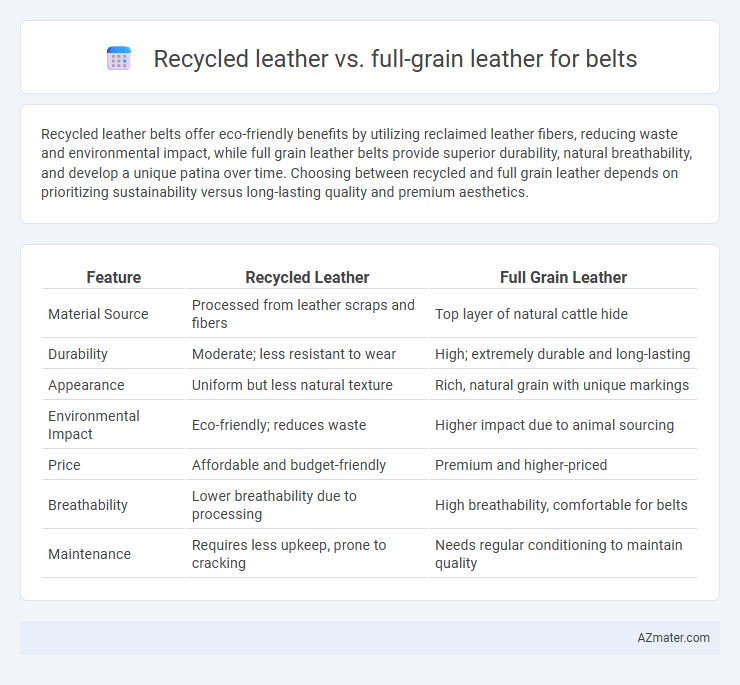Recycled leather belts offer eco-friendly benefits by utilizing reclaimed leather fibers, reducing waste and environmental impact, while full grain leather belts provide superior durability, natural breathability, and develop a unique patina over time. Choosing between recycled and full grain leather depends on prioritizing sustainability versus long-lasting quality and premium aesthetics.
Table of Comparison
| Feature | Recycled Leather | Full Grain Leather |
|---|---|---|
| Material Source | Processed from leather scraps and fibers | Top layer of natural cattle hide |
| Durability | Moderate; less resistant to wear | High; extremely durable and long-lasting |
| Appearance | Uniform but less natural texture | Rich, natural grain with unique markings |
| Environmental Impact | Eco-friendly; reduces waste | Higher impact due to animal sourcing |
| Price | Affordable and budget-friendly | Premium and higher-priced |
| Breathability | Lower breathability due to processing | High breathability, comfortable for belts |
| Maintenance | Requires less upkeep, prone to cracking | Needs regular conditioning to maintain quality |
Introduction: The Leather Belt Debate
Recycled leather belts offer an eco-friendly alternative by utilizing leather scraps bonded with polyurethane, reducing waste and environmental impact. Full grain leather belts provide unmatched durability and natural aging due to their intact top layer, which preserves the hide's original texture and strength. Consumers must weigh sustainability against longevity when choosing between recycled and full grain leather belts.
What Is Recycled Leather?
Recycled leather is created by shredding and reconstituting leather scraps and fibers, mixing them with binders to form a new material that mimics traditional leather's texture and appearance. This sustainable option reduces waste and environmental impact compared to full grain leather, which is made from the top layer of animal hide and prized for its durability, natural grain, and longevity. While recycled leather offers affordability and eco-friendliness, full grain leather belts provide superior strength, breathability, and develop a unique patina over time.
What Is Full Grain Leather?
Full grain leather is the highest quality leather made from the top layer of the hide, retaining the natural grain and imperfections that provide durability and character. It offers superior strength, breathability, and ages beautifully by developing a rich patina over time. Unlike recycled leather, which is typically made from leather scraps bonded together, full grain leather belts maintain structural integrity and long-lasting performance.
Durability: Which Leather Lasts Longer?
Full grain leather offers superior durability for belts due to its intact natural grain, resisting wear and tear over time, while recycled leather, made from bonded leather scraps, tends to be less robust and prone to cracking. The tightly packed fibers in full grain leather enhance strength and longevity, making it ideal for belts subjected to frequent use. Recycled leather's shorter fiber length and bonding process reduce its lifespan, leading to faster degradation under stress.
Appearance and Aging: Patina vs Consistency
Full grain leather belts develop a rich patina over time, enhancing their unique character and showcasing natural markings that reflect aging and wear. Recycled leather belts maintain a more consistent appearance without significant changes, as the material lacks the structural integrity to develop a genuine patina. The choice between a dynamic aging process with full grain leather and the steady look of recycled leather impacts both the visual appeal and longevity of a belt.
Environmental Impact: Sustainability Comparison
Recycled leather belts significantly reduce waste by utilizing leftover leather scraps and minimizing the demand for new animal hides, lowering carbon emissions and water consumption associated with traditional leather production. Full grain leather belts, while durable and long-lasting, involve intensive resource use including higher water consumption, chemical tanning processes, and considerable greenhouse gas emissions from livestock farming. Choosing recycled leather belts supports circular economy principles and offers a more sustainable alternative with a smaller environmental footprint compared to full grain leather.
Comfort and Flexibility
Recycled leather belts offer enhanced flexibility due to their composite structure, which often combines leather fibers with synthetic materials, resulting in a softer and more adaptable texture. Full grain leather belts, made from the top layer of the hide, provide superior breathability and natural comfort that improves with wear but tend to be stiffer initially. While full grain leather conforms to the body's shape over time, recycled leather delivers consistent flexibility and comfort right from the start, appealing to users seeking immediate softness.
Cost Analysis: Price Differences Explained
Recycled leather belts offer a budget-friendly alternative to full grain leather, with prices typically 40-60% lower due to the use of leather scraps and synthetic binders. Full grain leather belts command higher prices, reflecting their durability, natural texture, and long-lasting quality achieved through minimal processing. Consumers seeking affordable style may prefer recycled options, while those valuing premium craftsmanship often invest in the higher cost of full grain leather.
Maintenance and Care Requirements
Recycled leather belts require gentle cleaning with mild soap and avoid prolonged exposure to moisture to prevent deterioration, while full grain leather belts benefit from regular conditioning with specialized leather oils or balms to maintain suppleness and resist cracking. Full grain leather is more durable and develops a rich patina over time with proper care, whereas recycled leather may degrade faster and show signs of wear more quickly due to its composite nature. Both types should be stored in a cool, dry place away from direct sunlight to extend lifespan and maintain appearance.
Which Leather Is Best for Your Belt?
Full grain leather is the best choice for belts due to its durability, natural texture, and ability to develop a rich patina over time, ensuring long-lasting quality and aesthetic appeal. Recycled leather offers an eco-friendly alternative by repurposing leather scraps, but it typically lacks the strength and longevity of full grain leather, making it less ideal for everyday use. Choosing full grain leather guarantees a sturdy, high-performance belt that improves with age, while recycled leather suits those prioritizing sustainability over durability.

Infographic: Recycled leather vs Full grain leather for Belt
 azmater.com
azmater.com